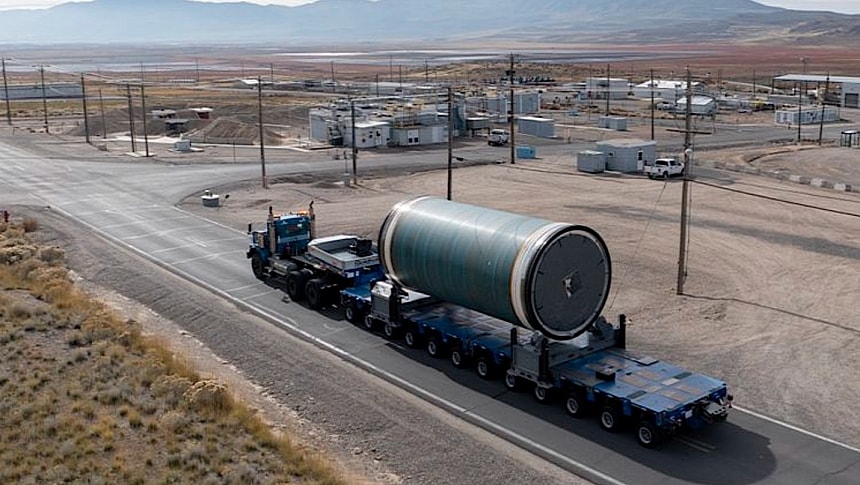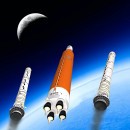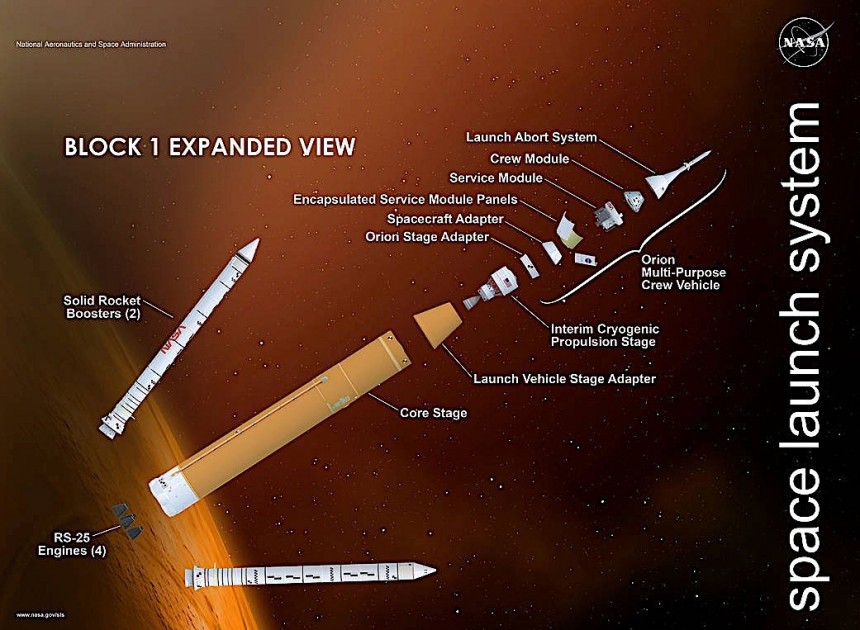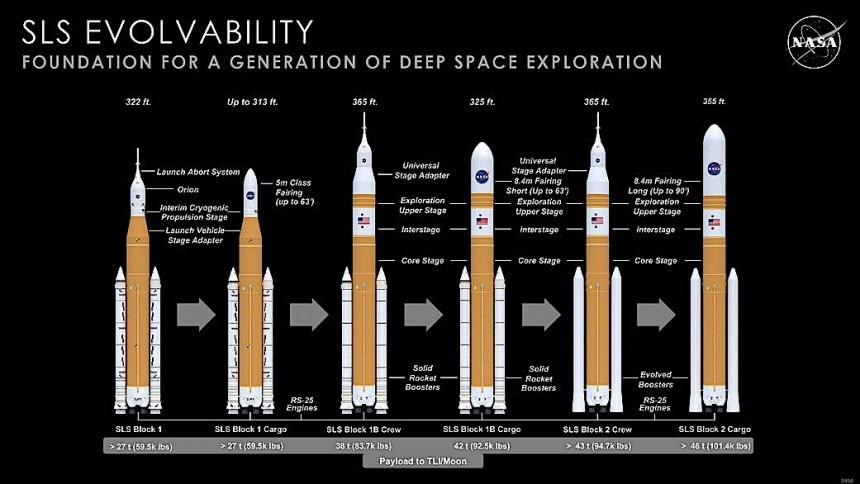The Space Launch System (SLS) rocket, specifically devised to advance the Artemis Moon exploration program, has been described from the start as the world's most powerful rocket. It already proved its worth during the single Artemis mission performed so far, and it will do the same over the coming two flights. But the current configuration of the hardware is by no means the final one, and something a lot more impressive looms over the horizon.
You see, NASA and its partners in this crime have imagined the SLS as an upgradable machinery. For Artemis I, II, and III, meaning the uncrewed test flight, the trip around the Moon with astronauts on board, and the first Moon landing of the modern era, the agency will use something called SLS Block 1.
The rocket is impressive both on paper and in real life. Designed to carry into space a total of 59,500 pounds (27 metric tons) of cargo, it comes with a four-engine core stage capable of developing over 2 million pounds of thrust, backed by two twin boosters that make up the difference to 8.8 million pounds of thrust, 15 percent more than the previous record holder, the Apollo-era Saturn V.
For post-Artemis III missions, the current version of the SLS will be replaced with something called Block 1B. This one will be developed in two configurations, crew and cargo, and it will be capable of lifting from the surface of the planet a total of 92,500 pounds (42 metric tons) of cargo in its uncrewed form.
The most impressive of all the rockets in the SLS family will of course be Block 2. It too will be made in crew and cargo variants, and it will probably become the rocket that will not only advance our exploration of the Moon, but will also possibly send the first humans to Mars.
Block 2 is scheduled to become operational just in time to serve the needs of Artemis missions IX and beyond. That's when NASA estimates it would have burned through the stock of Space Shuttle-era steel cases it uses in the current generation SLS.
An important element of the Block 2 core stage will be made using carbon fiber technology and a composite case that is meant to cut down weight. Other, so far unspecified upgrades should allow it to kick out its rear end 11 percent more total impulse than what the current, five-segment boosters are capable of.
That important element is called Booster Obsolescence and Life Extension, or BOLE for short, and it is the work of private contractor Northrop Grumman. You can admire the first of many BOLEs in the main photo of this piece.
We're talking about it now because Northrop Grumman just finished this motor segment of the Block 2 SLS, and it understandably seems to be very proud of it.
That's because this large piece of hardware will allow the Block 2 to send into space and on other worlds five more metric tons of payload than what the Block 1B will be capable of. That would be a total of 101,400 pounds (46 tons) of human-made stuff delivered to deep space.
Such a huge payload is made possible by one key attribute of this version of the rocket. As far as thrust levels are concerned, it will dwarf everything before it, with the total power levels standing at a staggering 9.5 million pounds of thrust.
Northrop Grumman says it plans to first true test of the BOLE segment of the rocket later this year, but we're not told exactly when. We do know what to expect, though, and that is a "full-scale static test with all five segments integrated and horizontally fired in a test bay."
As for when we'll get to see this evolved version of the SLS in action, that's still a very long time away. Technically, NASA plans the launch of the Artemis IX mission in 2033, but as we've seen recently, that could be pushed well beyond that year.
At the beginning of 2024 the American space agency announced it decided to no longer launch Artemis II this year, and Artemis III in 2025. It pushed both launches a year into the future (new dates are now 2025 and 2026, respectively) citing safety reasons that were not publicly detailed.
Regardless of the delay, it's clear NASA is determined not only to go to the Moon and return but also to stay there this time – there's even a lunar space station in the works. More importantly than that, constant references to preparatory and eventually crewed missions to Mars make us hopeful it could be something we'll get to see during our lifetimes.
And it all depends on the Space Launch System Block 2 whose first important component you can see above this text.
The rocket is impressive both on paper and in real life. Designed to carry into space a total of 59,500 pounds (27 metric tons) of cargo, it comes with a four-engine core stage capable of developing over 2 million pounds of thrust, backed by two twin boosters that make up the difference to 8.8 million pounds of thrust, 15 percent more than the previous record holder, the Apollo-era Saturn V.
For post-Artemis III missions, the current version of the SLS will be replaced with something called Block 1B. This one will be developed in two configurations, crew and cargo, and it will be capable of lifting from the surface of the planet a total of 92,500 pounds (42 metric tons) of cargo in its uncrewed form.
The most impressive of all the rockets in the SLS family will of course be Block 2. It too will be made in crew and cargo variants, and it will probably become the rocket that will not only advance our exploration of the Moon, but will also possibly send the first humans to Mars.
Block 2 is scheduled to become operational just in time to serve the needs of Artemis missions IX and beyond. That's when NASA estimates it would have burned through the stock of Space Shuttle-era steel cases it uses in the current generation SLS.
An important element of the Block 2 core stage will be made using carbon fiber technology and a composite case that is meant to cut down weight. Other, so far unspecified upgrades should allow it to kick out its rear end 11 percent more total impulse than what the current, five-segment boosters are capable of.
We're talking about it now because Northrop Grumman just finished this motor segment of the Block 2 SLS, and it understandably seems to be very proud of it.
That's because this large piece of hardware will allow the Block 2 to send into space and on other worlds five more metric tons of payload than what the Block 1B will be capable of. That would be a total of 101,400 pounds (46 tons) of human-made stuff delivered to deep space.
Such a huge payload is made possible by one key attribute of this version of the rocket. As far as thrust levels are concerned, it will dwarf everything before it, with the total power levels standing at a staggering 9.5 million pounds of thrust.
Northrop Grumman says it plans to first true test of the BOLE segment of the rocket later this year, but we're not told exactly when. We do know what to expect, though, and that is a "full-scale static test with all five segments integrated and horizontally fired in a test bay."
As for when we'll get to see this evolved version of the SLS in action, that's still a very long time away. Technically, NASA plans the launch of the Artemis IX mission in 2033, but as we've seen recently, that could be pushed well beyond that year.
Regardless of the delay, it's clear NASA is determined not only to go to the Moon and return but also to stay there this time – there's even a lunar space station in the works. More importantly than that, constant references to preparatory and eventually crewed missions to Mars make us hopeful it could be something we'll get to see during our lifetimes.
And it all depends on the Space Launch System Block 2 whose first important component you can see above this text.



















